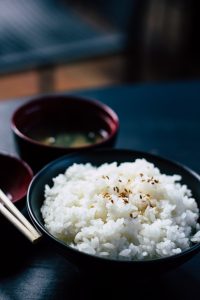 Rice does not start out brilliantly white, like you find in the store. It’s highly processed and the husk and bran have been removed, making white rice not only less nutritious, but mostly carbs. That can be dangerous for diabetics, since it can cause spikes in blood glucose levels. Even rice milk may create a problem, since it’s high in sugar content without the fiber to slow the absorption. Compared to brown rice, it has far less fiber, manganese, selenium, antioxidants and lignans. It also can cause weight gain due to the lack of fiber, which leaves you feeling fuller longer.
Rice does not start out brilliantly white, like you find in the store. It’s highly processed and the husk and bran have been removed, making white rice not only less nutritious, but mostly carbs. That can be dangerous for diabetics, since it can cause spikes in blood glucose levels. Even rice milk may create a problem, since it’s high in sugar content without the fiber to slow the absorption. Compared to brown rice, it has far less fiber, manganese, selenium, antioxidants and lignans. It also can cause weight gain due to the lack of fiber, which leaves you feeling fuller longer.
If you want food that will boost your energy, white rice might be appropriate.
As noted before, white rice is mostly carbohydrates and carbs are a good source of energy. When combined with a source of protein, it could be a great option for a pre or post workout snack. For anyone trying to maintain or gain weight, it’s also a healthy option that’s far better than a candy bar or junk food.
While white rice does not contain as many nutrients as brown rice, it’s not empty calories.
White rice still has significant amounts of nutrients such as iron, calcium, folate, thiamine, vitamin D and niacin. If you’re on a low sodium diet, white rice is a good addition, too. Not only is it low in sodium, it’s also low in fat. It offers approximately 4 to 5 grams of protein per serving, too. If you’re trying to avoid gluten, are gluten intolerant or have celiac disease, it’s an option, since it contains no gluten.
If stomach problems plague you, white rice might be a good option.
White rice is so much easier to digest than brown rice, it’s a good option when you have digestive issues. Brown rice contains phytic acid, which can cause issues with digestion. If you have to eat a later meal, including the easy to digest white rice can fill you up and help you sleep, but since it’s easy to digest, won’t interfere with your quality of sleep.
- While white rice has far less fiber than brown rice, it still has some and is easier on the digestive tract. The fiber is soluble fiber–a resistant starch that are broken down by gut microbes to produce butyrate. It can reduce stomach inflammation
- Recent studies show that you can cut calories in half and lower the glycemic index of white rice by cooking it differently. Add a tiny amount of coconut oil to the boiling water before adding the rice. Let the rice cool in the refrigerator for 12 hours, then reheat and eat.
- Some types of white rice are enriched with additional nutrients. Those varieties may contain more iron, folate and thiamine. If you’re convinced only white rice will do, look for those varieties.
- You can reduce the GI of white rice by combining it with high fiber foods, like vegetables. Unlike some dishes, where the rice is the biggest portion of the meal, use it more sparingly and combine more vegetables and meat.
For more information, contact us today at Next Level Fitness
